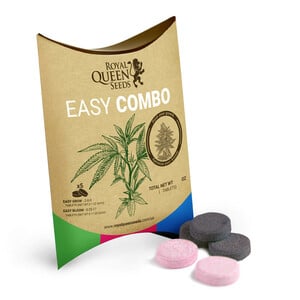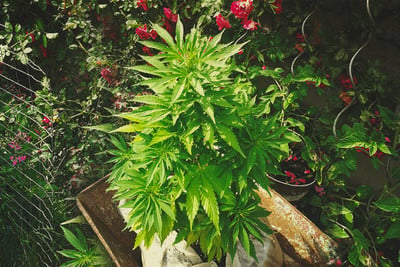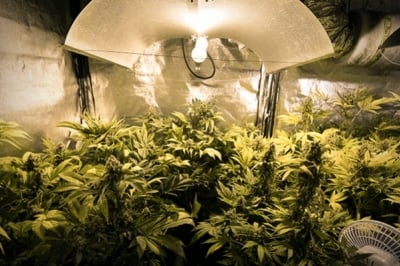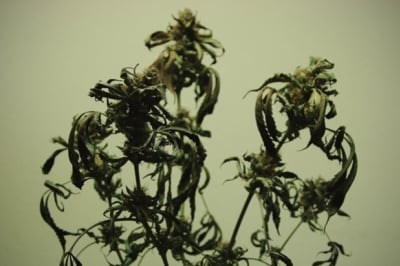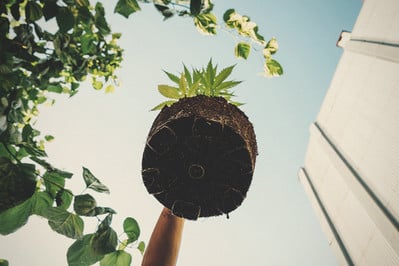.

Top 10 Tips For Growing Cannabis: Answers To Your FAQs
Growing cannabis is a process that requires attention to detail and a significant investment of time, effort, and money. If you want to optimise your resources and maximise your yields, check out the answers to your most frequently asked questions about growing weed below.
Contents:
- How important is genetics when growing weed?
- What is the best cannabis growing medium?
- Do i need nutrients to grow cannabis?
- What are the best grow lights for indoor growing?
- Do i need a fan in my grow tent?
- How can i achieve the perfect climate for growing cannabis?
- How often do i have to water my cannabis plants?
- Will training my plants help me get fatter buds?
- When is the best time to harvest marijuana buds?
- Is drying and curing important when growing cannabis?
Truth is, while growing weed successfully isn’t necessarily difficult, it is a learning process, and mistakes can, and will, be made. To help you with your grow right from the start, and so you can look forward to a great harvest, here are the answers to 10 frequently asked questions about growing weed.
HOW IMPORTANT IS GENETICS WHEN GROWING WEED?
Genetics plays a significant role in the yield, taste, aroma, and overall growing traits of your plant. Seed selection is therefore a crucial part of the growing process as it will heavily influence the final outcome.
Every grower will have their own preferences when it comes to strains. Some may prefer a powerful, cerebral sativa that leaves them feeling energised and motivated. Others may like a stoney indica or a medicinal strain high in CBD.
The environment where you’re growing is another important factor when choosing cannabis genetics. If you’re growing in a small indoor space, an autoflowering variety can be optimal. Or maybe you’re planning an outdoor grow and want to grow a gigantic cannabis tree. Other factors, such as climate, will also play a role when choosing genetics.
Free RQS
Grow Guide!

WHAT IS THE BEST CANNABIS GROWING MEDIUM?
There are many ways to grow cannabis—from sowing seeds in a pot of soil to advanced hydroponic setups. There are different substrates (growing media) you can choose from, including soil, coco coir, and clay pebbles. Some techniques, such as hydroponics, don’t require a substrate at all. Let’s stay with growing in soil for now, as this is what most cultivators use.
What makes a great cannabis soil?
• Light texture: Soil should have a light and airy texture. This way, roots can grow effortlessly with easy access to oxygen.
• Water drainage: Water should drain well, as cannabis doesn’t like to have “wet feet” for long.
• Water retention: Water draining too fast from the pot isn’t optimal either. The soil should be able to hold water (and nutrients) for a reasonable period.
• Optimal pH: The pH level of your soil should be about 6.0. A little above or below (5.8–6.3) is okay, but if the pH is way off, your yield will suffer.
• Nutrients: Soil made specifically for growing cannabis should already contain nutrients. Most store-bought soils contain enough nutrients for 3–4 weeks of growth.
If you’re new to growing, the best option is to source a ready-made cannabis substrate from a reputable brand. These already have the right structure and contain enough nutrients to get a grow going.
• Pro tip: If you want to grow organically, you can make your own super soil. Organic material such as compost or bat guano can support the growth of beneficial microbes that will produce nutrients for your plants. This way, you won’t need to give additional nutrients; you’ll only need to water your plants. Mother Nature will take care of everything else and reward you with juicy buds with a natural flavor.
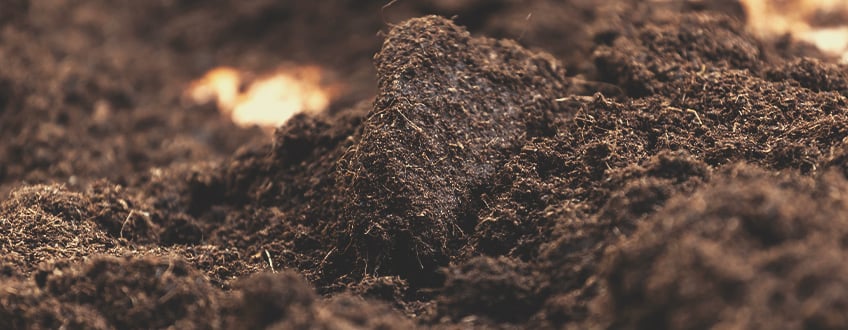
DO I NEED NUTRIENTS TO GROW CANNABIS?
Unless you’re an experienced grower setting up a purely organic grow (see the previous point), the answer is: Yes, you will (likely) need cannabis nutrients. But don’t just go crazy, as many fatal mistakes can be made if you’re not careful.
More nutrients doesn’t mean more buds. Overfeeding can easily happen, and indeed it is one of the most common mistakes. Seedlings and very young plants don’t need nutrients at all. If you’re growing autoflowers, they will also need less nutrients than photoperiod plants.
If you’re getting soil from a store, chances are it’s already pre-fertilised: These nutrients normally last 3–4 weeks, which is also the average duration of the vegetative phase. Spoken differently, with good soil, you will likely not need to give nutrients until the flowering phase begins.
Cannabis plants require different concentrations of nutrients during each phase of growth. Here are the recommended NPK (nitrogen, phosphorus, potassium) ratios for veg and flowering:
• Veg NPK: During vegetative growth, cannabis desires a high:low:medium NPK ratio (e.g. 3:1:2) with lots of nitrogen.
• Flowering NPK: Because plants have stopped growing and are now spending energy on producing buds, they need a low:high:medium NPK ratio (e.g. 1:3:2) with little nitrogen but plenty of phosphorus and potassium. To promote bud development in the final weeks of the flowering stage, we recommend modifying the NPK ratio to 0:3:3.
In addition to these basic macronutrients, cannabis also needs micronutrients such as calcium, iron, zinc, etc. Cannabis nutrients normally contain both macro and micronutrients.
• Pro tip: Providing nutrients for your plants is only part of the story. Equally important is that your water/nutrient solution has the proper pH. With an incorrect pH, the plants can’t take in nutrients even if they are present. The optimal pH level for cannabis grown in soil is 6.0–7.0pH. You can adjust the pH of your water with pH down or pH up products.
If you are an advanced gardener, you can make things easier with organic cultivation. With organic fertilisers, microorganisms will feed your plants for you. pH level fluctuations will also be less of an issue.
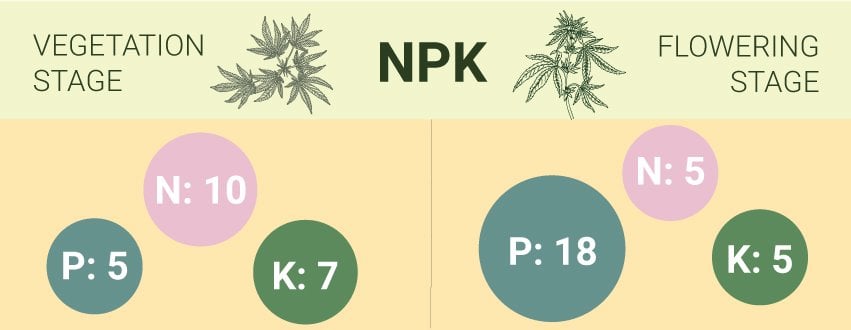
WHAT ARE THE BEST GROW LIGHTS FOR INDOOR GROWING?
Of all things, light is probably the most important part of your growing operation; the more, the better! Getting the best light is about finding a good balance between cost and yield, and finding the right type of light from the many options available.
• CFLs: Compact fluorescent lights fit in common light sockets and are widely available. These low-intensity lights are used exclusively for seedlings and vegging, and they only use a little electricity.
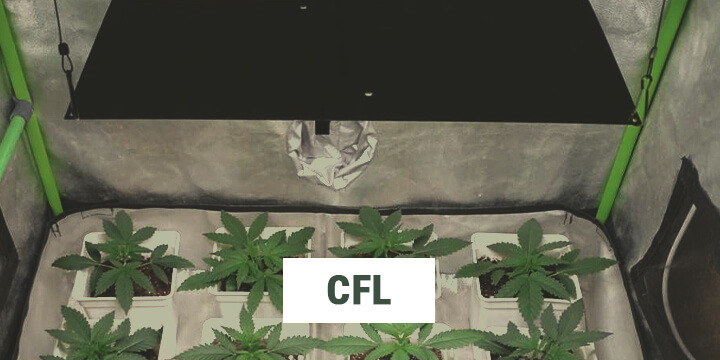
• HID lights: The two main types of HID (high-intensity discharge) lamps are MH (metal halide) and HPS (high-pressure sodium). MH lamps can be used for vegging, and HPS lights for flowering. They are affordable, but use lots of electricity and produce lots of heat.

• LEDs: Modern LEDs for growing now rival HID lights, and their prices have dropped significantly since first appearing on the market. The biggest advantage of LEDs is that they use much less energy than HID. However, the initial cost for quality LED grow lights can be higher.
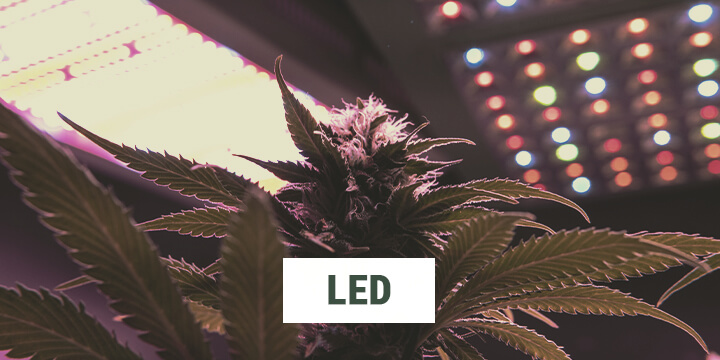
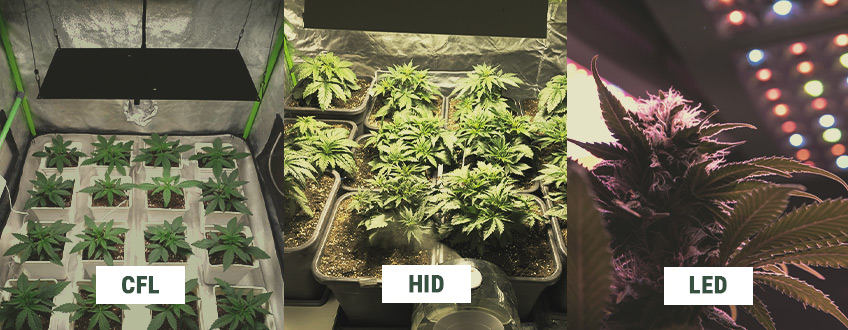
If you’re just starting out with cultivation, look into “full-spectrum” LED lights from a reputable manufacturer. Full-spectrum means these lights are good for vegging and flowering. Don’t skimp on your lights, as this is where it’s worth spending a little more.
• Pro tip: Some grow lights also emit UVB light, which is said to increase trichome production for more potent buds.
• Pro tip: Don’t burn your plants! Avoid light burn (bleached and crumpled leaves) by placing your lamps at an appropriate distance from your cannabis plants. Consult the manufacturer for the recommended distance. Keep in mind that seedlings and young plants are particularly sensitive to light stress!
DO I NEED A FAN IN MY GROW TENT?
A simple fan in your grow tent blowing a steady stream of air across your plants can provide lots of advantages:
• Prevents mold growth from stagnant, humid air
• Strengthens the stems with a gentle breeze
• Can deter some pests like mites and fungus gnats
• Prevents bud rot
But don’t go overboard. Set the fan so it blows a gentle breeze without overly stressing or damaging your plants. An oscillating fan is best.
HOW CAN I ACHIEVE THE PERFECT CLIMATE FOR GROWING CANNABIS?
There are two important variables for achieving the perfect climate when growing indoors: temperature and humidity. Both must be optimised for healthy growth. However, the optimal values for each depend on the growing stage of your plants:
| HUMIDITY | T. LIGHTS ON | T. LIGHTS OFF | |
|---|---|---|---|
| SEED | 65–70% | 20–25°C | 4–5°C lower |
| GROWTH PHASE | 40–70% | 22–28°C | 4–5°C lower |
| FLOWERING PHASE | 40–50% (Prevent mold!) | 20–26°C | 5–8°C lower |
| LATE FLOWERING PHASE | 30–40% | 18–24°C | 5–10°C lower |
| HUMIDITY | TEMPERATURE (LIGHTS ON) | TEMPERATURE (LIGHTS OFF) | |
| SEED | 65–70% | 20–25°C | 4–5°C lower |
| GROWTH PHASE | 40–70% | 22–28°C | 4–5°C lower |
| FLOWERING PHASE | 40–50% (Prevent mold!) | 20–26°C | 5–8°C lower |
| LATE FLOWERING PHASE (1–2 weeks before harvest) | 30–40% | 18–24°C | 5–10°C lower |
HOW OFTEN DO I HAVE TO WATER MY CANNABIS PLANTS?
Incorrect watering (overwatering and underwatering) is, hands-down, the most common mistake when growing marijuana. Watering too frequently leads to all sorts of problems, from mold and fungus to root rot and nutrient lockout. Underwatering dehydrates your plant and stunts healthy growth, although it is less threatening than overwatering.
How to water properly? Water less frequently so the soil can dry out between sessions. Test it by putting a finger into the soil. If the top 1.2 – 1.6 inches feels dry, you can water your plants.
Underwatering cannabis is less of a problem. Should a plant temporarily droop from being thirsty, it will usually recover within hours once watered.
• Pro tip: A good way to test if it’s time to water is to compare the weight of your growing container when dry versus drenched. This way, you’ll be able to tell if your plants need some water by lifting up the pot.
WILL TRAINING MY PLANTS HELP ME GET FATTER BUDS?
Plant training techniques such as pruning, topping, and LST (low-stress training) can certainly be beneficial. If you are growing indoors, these techniques can optimise available space (i.e: more plants per square metre) for increased yields. As plant training also means more light can reach more budding sites, it should give you more and fatter buds.
By performing low-stress training outdoors, where you gently bend and tie down the branches of your plant to grow more horizontally, you can keep your grow more discreet.
• Pro tip: Support your plants with string and stakes to help them carry the load of the heavy buds to come. These will also come in handy if you decide to use low-stress training.
WHEN IS THE BEST TIME TO HARVEST MARIJUANA BUDS?
You want to harvest at the right time: Not too early, as you want your buds to mature to their full size, potency, and flavor, but also not too late, since the potency will at some point start to degrade.
You know harvest time is near when most of the leaves on your plant have turned yellow and the pistils (hair-like growths on the buds) have turned from white to a deep orange or brown.
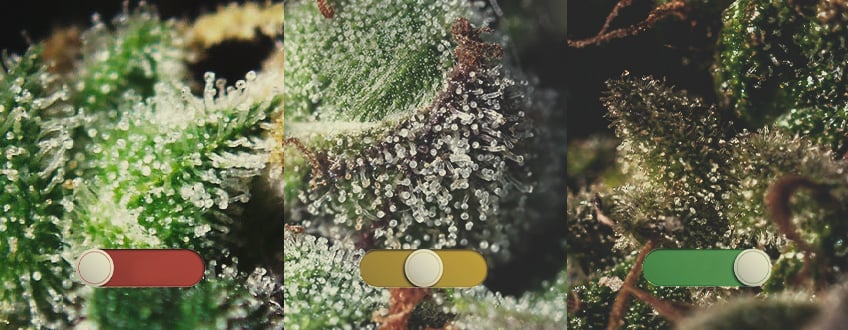
• Pro tip: Just taking a look at your plant isn’t an exact method to determine harvest time. A more reliable method is to inspect the trichomes—tiny mushroom-shaped outgrowths found on the buds. The trichomes change color to indicate when the buds are ready. Use a loupe and take a good look at them:
• Trichomes clear: Harvest is still a few weeks away
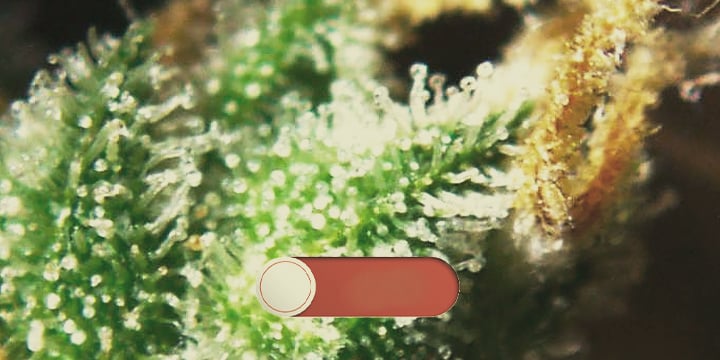
• Trichomes milky white: Reaching maximum THC production, still 1–2 weeks from harvest
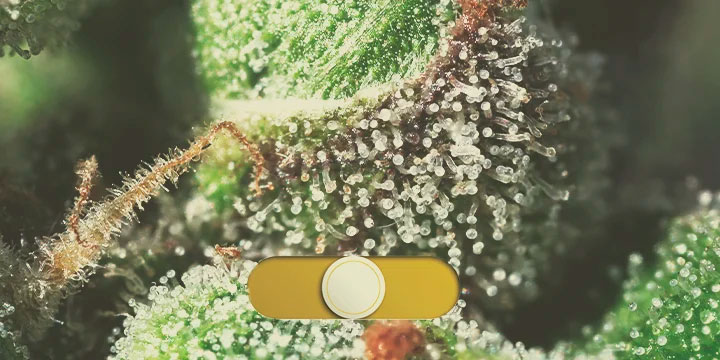
• Some trichomes amber/brown, rest remain white: Perfect time to harvest!
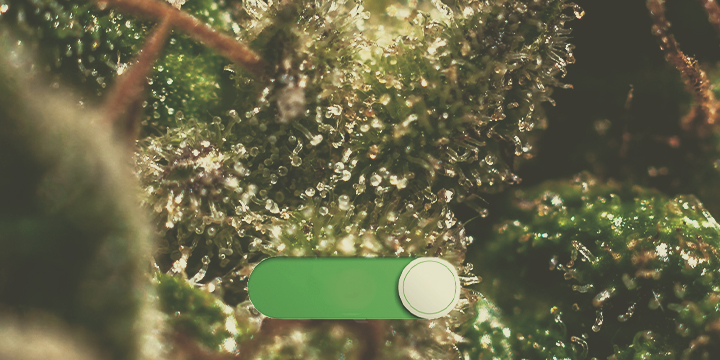
Many growers harvest when a small portion (10–20%) of the trichomes have turned amber. At this point, some of the THC in the buds has already started to degrade. This produces a more relaxing high as compared to when all the trichomes are white, which makes for a more heady, psychoactive effect.
IS DRYING AND CURING IMPORTANT WHEN GROWING CANNABIS?
It is immensely important. Drying and curing allows your bud to fully develop its aroma and potency. Some say that the weeks after harvest are as important as the entire grow.
• Drying your buds: After harvesting and trimming, hang your buds in a dark room with good air circulation and a relative humidity of about 45–55%. You want to dry your bud SLOW for best results, which will take anywhere from 7–12 days. Some growers trim after drying, which prolongs drying time but may result in a better taste.
To test if your bud is dry, take a small branch and try to bend it. If it snaps, your buds are dry and you’re ready to move on to the curing process. If they just bend, they need a little longer to dry.
• Curing your buds: When your buds have dried, place them in mason jars or jam jars with a lid. Fill the jars about ¾ of the way so there’s room left for some air. Place the jars in a dry, dark environment like a cupboard.
As your buds cure, make sure to check on them daily. Open the lid every day and let your buds “breathe” for 30 minutes. This will pull excess moisture out of your jars and surround your buds with fresh air. Give everything a good stir to make sure all the buds can breathe. The curing process can take anywhere from 4–8 weeks and beyond. If you can’t wait, you can test some buds after two weeks; but for best results, you should wait the entire time.


























